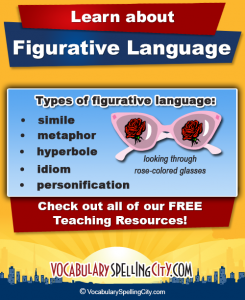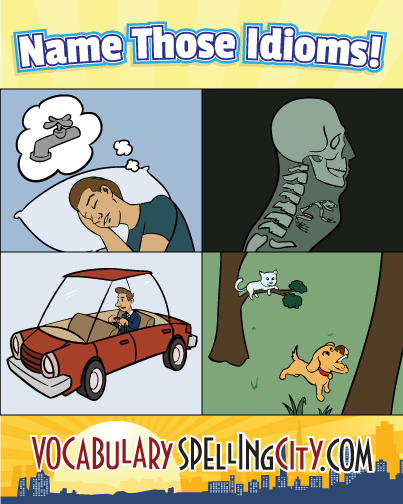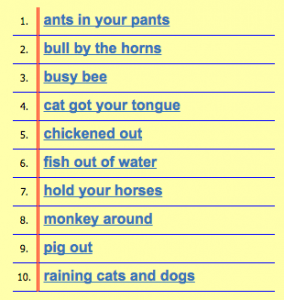
Any Port in a Storm!
Now that Hurricane Irma has past, I’m riding home to Ft Lauderdale. VocabularySpellingCity is headquartered in South Florida so we shut the office last week and everyone scurried like ants to safety. In my case, my “port” was a dog-friendly motel in Alpharetta, Georgia.
For some reason, this idiom – “Any Port in a Storm” – kept playing in my head like a brain worm. One reason the expression kept playing is that I’ve been thinking about how we can help students learn idioms and figurative language.
English literacy is a challenge for many reasons, one of which is the constant use of figurative language. The typical elementary student is very literal and can have trouble absorbing some of the metaphors that we typically use. A 2nd grader might “raise their eyebrows” when I respond to a question about whether I like the motel with: “I love it, any port in a storm. I’m not going to look a gift horse in the mouth.”
For ELL students, many American idioms are both obscure references and rely on cultural references that can be hard for them to relate to. Imagine how an ELL student might struggle when the teacher, encouraging her before a performance, says: “You’re on deck, soon up at bat, so get in the zone. I’m sure you won’t strike out.” Would words like that be as clear as mud to a recent immigrant?
On the other hand, much of our vocabulary has figurative origins that make the words easier to learn and remember if the teacher highlights these origins. For instance, knowing that the word “lousy” originally literally meant “lice-infested” makes ” lousy” a much more dramatic expression. And on the subject of lice, what other expression derives from dealing with those annoying infestations? (The answer of course is nit-picking. Nits are the little lice eggs that have to be painstakingly picked out of the hair.)
A few things about teaching idioms.
- Teaching idioms should be fun. Want an idea: Have a different student each day be responsible for teaching a new animal-based idiom to the class. Once you start to exhaust animal based expressions, you can pivot to sports idioms.
- VocabularySpellingCity can help. Our lists can use not just words, but short expressions (up to 4 spaces are allowed. So “smart like a fox” will work!)
- There’s every reason to make a point of out using idioms when talking as long as you take the time to highlight and clarify them. It also makes sense to have a time during the day when all the students are urged to talk with idioms.
- The VocabularySpellingCity teaching resources includes preconfigured figurative language lists of several types:
Hyperbole – exaggeration used to emphasize a point or to add excitement or humor. Examples:

Figurative Language Types
- I can smell my mom’s brownies a mile away.
- I have a ton of homework.
- I’ve seen this movie a thousand times.
Idiom – expression in which the intended meaning is different from the literal meaning. Examples:
- Don’t judge a book by its cover.
- It’s raining cats and dogs.
- Who let the cat out of the bag?
Metaphor – direct comparison between two dissimilar things.Examples:
- Her voice was music to my ears.
- You are my knight in shining armor.
- Snow covered the streets in a white blanket.
Personification – literary device used to give human characteristics to nonhuman objects. Examples:
- The palm trees were dancing in the wind.
- The carved pumpkin smiled at us.
- The car’s engine coughed its last breath.
Simile – comparison between two unlike things using the word “like” or “as.” Examples:
- The teenager is as hungry as a wolf.
- The old man is as wise as an owl.

Guess that Idiom #1
- The new dad is as proud as a peacock.
And as icing on the cake, I’ll point out the figurative language materials on our site are correlated to each state standards (also to Canadian and Australian standards). Using the CCSS a starting point, proficiency standards are defined as of 3rd grade.
Common Core State Standards Related to Figurative Language
CCSS.ELA-Literacy.L.3.5
Demonstrate understanding of figurative language, word relationships and nuances in word meanings.
CCSS.ELA-Literacy.L.3.5.a
Distinguish the literal and nonliteral meanings of words and phrases in context.
CCSS.ELA-Literacy.L.4.5.a
Explain the meaning of simple similes and metaphors (e.g., as pretty as a picture) in context.
CCSS.ELA-Literacy.L.4.5.b
Recognize and explain the meaning of common idioms, adages, and proverbs.
One of the most exciting things about teaching idioms is that each student can research idioms around their own interest: animals, cooking, sports, and so on.
So is teaching idioms as easy as pie? Do you know your types of idioms like the back of your hand? With this head start, are you ready to knock it out of the park with your teaching? Don’t be a stranger, tell me what you think. Comment below, tweet to me @VSpellCityMayor, or Facebook me on our Facebook page.

No comments:
Post a Comment